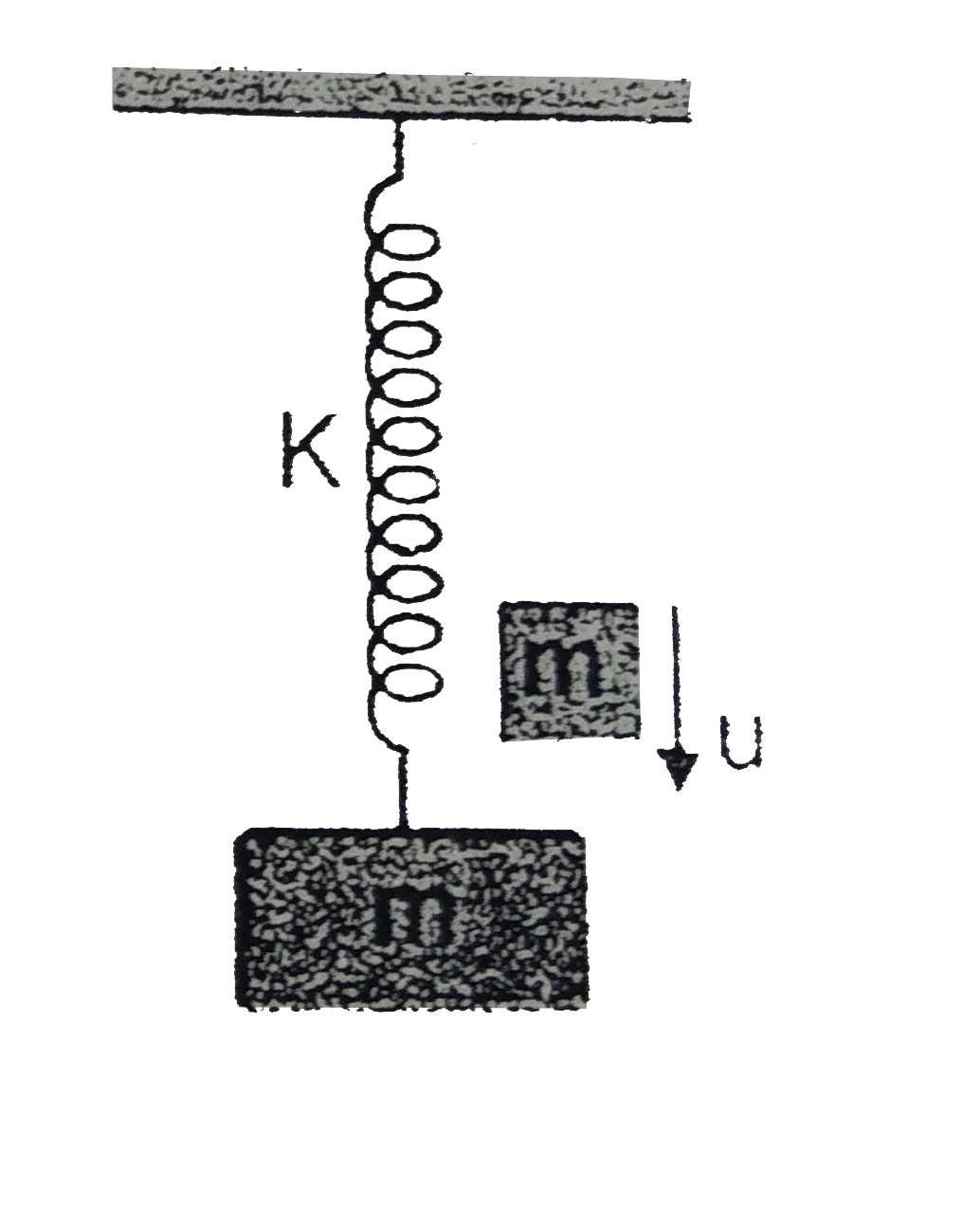
A block A of mass m is give a velocity v0 towards another block B of sae mass B. Is attached to an ideal spring of spring constant K. A makes a head on perfectly inelastic collision with B.
Answer the following two questions:
Q. Choose the correct option (s)
Maximum elongation in the spring during subsequent motion is 12√mv20K
Maximum elongation in the spring during subsequent motion is √mv202K
Final velocity of block A is v02
Final velocity of block A is V04
The correct Answer is:A, C
Max compression in spring
12(2m)(v02)2=12KX21⇒X1=√(mv20)2K⎞⎟
⎟⎠
Max elongation in spring
12m(v02)2=12KX22⇒X2=12√mv20K
B makes first half oscillation with A.
So, t1=π√2mK
B makes rest half oscillation alone
t2=π√mk
t=t1+t2=π√mK(√2+1)
Topper's Solved these Questions
- TEST PAPERSBook:RESONANCEChapter:TEST PAPERSExercise:PT-01
Explore 30 Videos
- TEST PAPERSBook:RESONANCEChapter:TEST PAPERSExercise:Pt-02
Explore 30 Videos
- TEST PAPERSBook:RESONANCEChapter:TEST PAPERSExercise:PART - II PHYSICS
Explore 107 Videos
- SIMPLE HARMONIC MOTION Book:RESONANCEChapter:SIMPLE HARMONIC MOTION Exercise:Advanced Level Problems
Explore 13 Videos
- TEST SERIESBook:RESONANCEChapter:TEST SERIESExercise:PHYSICS
Explore 127 Videos
Similar Questions
Knowledge Check

A block A of mass m is give a velocity v0 towards another block B of sae mass B. Is attached to an ideal spring of spring constant K. A makes a head on perfectly inelastic collision with B.
Answer the following two questions:
Q. Let the collision takes place at time t=0 choose the instant (s), when the spring is in its natural length.Aπ√2mKB2π√2mKCπ√mK(√2+1)D2π√mKA block of mass m moving with a velocity v0 collides with a stationary block of mass M to which a spring of stiffness k is attached, as shown in Fig. Choose the correct alternative(s)
 AThe velocity of the centre of mass is v0BThe initial kinetic energy of the system in the centre of mass frame is 14(mMM+m)v20CThe maximum compression in the spring is v0√(mMm+M1k)DWhen the spring is in the state of maximum compression, the kinetic energy in the centre of mass frame is zero
AThe velocity of the centre of mass is v0BThe initial kinetic energy of the system in the centre of mass frame is 14(mMM+m)v20CThe maximum compression in the spring is v0√(mMm+M1k)DWhen the spring is in the state of maximum compression, the kinetic energy in the centre of mass frame is zeroConsider a block of mass 'm' attached to a spring of spring constant 'K' as shown. Now a block of same mass 'm' moving with velocity 'u' strikes the other block and stick to it. Both blocks collectively start performing SHM.

Choose the correct option(s) :AThe maximum extension in the spring is 2mgK+A (Where 'A' is amplitude)BThe maximum extension in the spring is 2mgK (Where 'A' is amplitude)CThe velocity of the block at the instant is at maximum extension is zero.DThe maximum extension in the spring is 2mgK+2A (Where 'A' is amplitude)
In the fig 4.24 a block of mass m moves with velocity v0 toward a stationaly block of a mass M on a smooth horizontal surface. Find the maximum compression in the spring of stiffnesss constant K.

View Solution Block C of mass M is moving with velocity V0 and collides elastically with block A of mass M and connected to another block B of mass 2M through a spring of spring constant K. What is K if X0 is the compression of spring when velocity of A and B is same
Block C of mass M is moving with velocity V0 and collides elastically with block A of mass M and connected to another block B of mass 2M through a spring of spring constant K. What is K if X0 is the compression of spring when velocity of A and B is same
View SolutionA block of mass m is moving with an initial velocity v0 towards a stationary spring of stiffness k attached to the wall as shown in figure

a. Find the maximum compression in the spring.
b. Is the work done by the spring negative or positive?
View SolutionIn the figure shown, a block A of mass m is rigidy attached to a light spring of stiffness k and suspended from a fixed support. Another block B of same mass is just placed on it and blocks are in equilibrium. Suddenly the block B is removed. Choose the correct options (s) afterward.

View Solution Block C of mass M is moving with velocity V0 and collides elastically with block A of mass M and connected to another block B of mass 2M through a spring of spring constant K. What is K if X0 is the compression of spring when velocity of A and B is same
Block C of mass M is moving with velocity V0 and collides elastically with block A of mass M and connected to another block B of mass 2M through a spring of spring constant K. What is K if X0 is the compression of spring when velocity of A and B is same
View Solution


